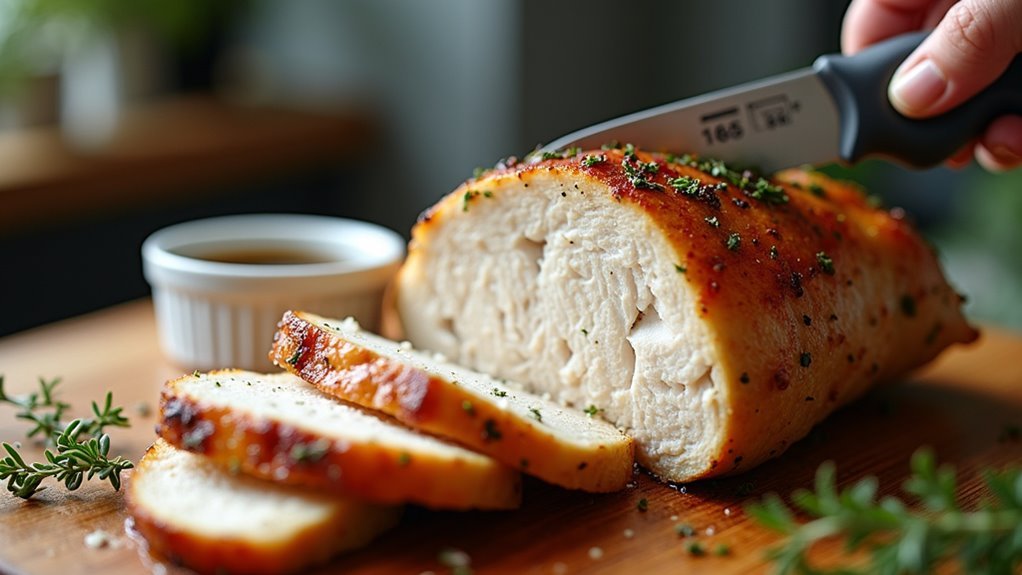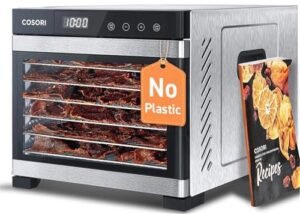Few food safety questions trigger as much debate as whether pink chicken is safe to consume. Most home cooks have been taught that poultry should always be white throughout, yet that’s not entirely accurate. Chicken can remain pink for various reasons that have nothing to do with being undercooked. The color itself isn’t necessarily dangerous – temperature is what truly matters. Perhaps what’s most important isn’t what we see, but what we measure. This distinction has likely saved many perfectly good meals from being unnecessarily discarded.
Table of Contents
ToggleUnderstanding the Pink Color in Cooked Chicken

While many people immediately assume pink chicken is unsafe to eat, the reality is more nuanced than this simple color judgment.
Color alone isn’t always the best indicator of whether chicken has been properly cooked. Sometimes, perfectly safe chicken can retain a pinkish tinge due to several factors.
Smoking processes often create a “smoke ring” that appears pink. Chicken cooked near the bone might show pinkness from bone marrow. Even the chicken’s age and diet can influence the final color after cooking.
What really matters is temperature. Most experienced grillers know that relying on a good meat thermometer, rather than color, is perhaps the wisest approach to guarantee safety.
The Science Behind Chicken Doneness

The temperature of chicken matters greatly more than its color when determining if it’s safe to eat.
Temperature, not color, is the true measure of chicken’s safety—trust the thermometer, not your eyes.
While many home cooks rely on visual cues, the USDA is quite clear that chicken must reach 165°F internally to kill harmful bacteria like Salmonella or Campylobacter.
I think we’ve all worried about pink chicken at some point.
The reality is that chemical reactions during cooking can leave perfectly safe chicken with a pinkish hue, especially near bones.
Perhaps what’s most important for our community of food enthusiasts is investing in a good meat thermometer – it’s truly the only reliable way to know your chicken is done.
USDA Guidelines for Safe Poultry Consumption

Safety guidelines from the USDA offer rock-solid recommendations that leave little room for interpretation when it comes to poultry consumption.
These guidelines aren’t just bureaucratic hoops—they’re designed to protect us all from foodborne illnesses that, frankly, nobody wants to experience.
When preparing chicken, remember these vital temperature points:
- Always cook chicken to a minimum internal temperature of 165°F
- Use a properly calibrated meat thermometer placed in the thickest part
- Allow for a brief rest period after reaching temperature
Perhaps the most reassuring thing about following these guidelines is knowing we’re all sitting down to meals that are both delicious and safe.
Temperature, not color, is what truly matters.
Why Meat Thermometers Are Your Most Reliable Tool
Speaking of reliable indicators, meat thermometers stand as the unrivaled champions in determining whether your chicken is safe to consume.
When that pinkish tinge leaves you second-guessing, a quick temperature check eliminates all doubt.
Many of us have probably tossed perfectly good chicken because of color concerns, while others might have risked serving undercooked poultry.
A well-calibrated thermometer ends this guesswork. Simply insert it into the thickest part of the meat, away from bone, and verify it reaches 165°F.
Special Considerations for Smoked Chicken
When it comes to smoked chicken, traditional doneness indicators require special consideration. The smoke ring—that pinkish layer just beneath the surface—is often mistaken for undercooked meat, but it’s actually a chemical reaction between smoke and myoglobin.
Smoked chicken challenges our cooking instincts—that pink smoke ring isn’t underdone meat, just chemistry at work.
This can leave chicken looking pink even when it’s perfectly safe to eat.
For those new to smoking chicken, here are three essential points to remember:
- Pink coloration around bones or within the smoke ring is normal and safe.
- Higher smoking temperatures (300-325°F) produce better results than lower temps.
- Always verify doneness with a thermometer, not by color alone.
Additionally, using a digital meat thermometer can help ensure you accurately check the chicken’s internal temperature.
I think many home smokers worry unnecessarily about pink chicken.
Perhaps understanding these smoking nuances helps bring peace of mind to your backyard barbecues.
Frequently Asked Questions
How Does Chicken Marinade Color Affect Safety Perception?
Marinade colors can mislead consumers about chicken safety. Red or dark marinades may mask pinkness that signals undercooking, while consumers often mistake naturally occurring pink hues for unsafe meat.
Can Freezing Chicken Before Cooking Impact the Final Color?
Like frost kissing a rose, freezing chicken can indeed impact its final color. The freezing process may damage cell membranes, causing moisture loss that affects how proteins react during cooking, potentially resulting in color variations.
Do Antibiotics in Chicken Feed Affect Meat’s Pink Coloration?
Research doesn’t indicate that antibiotics in chicken feed directly affect meat coloration. Pink tinge is more commonly related to cooking methods, bone marrow leakage, and smoke reactions during preparation.
Is Pink Chicken More Concerning for Children or Immunocompromised Individuals?
Like a hidden trap in familiar terrain, pink chicken poses heightened risks for children and immunocompromised individuals. These vulnerable groups face greater danger from foodborne pathogens potentially present in undercooked poultry, requiring extra vigilance.
Do Heritage Chicken Breeds Display Different Color Characteristics When Cooked?
Heritage chicken breeds may indeed display different color characteristics when cooked due to variations in myoglobin content, muscle structure, and bone composition resulting from their diverse genetic backgrounds.
Conclusion
When it comes to chicken safety, don’t judge a bird by its color. Pink chicken can be perfectly safe when internal temperature reaches 165°F, regardless of its hue. While visual cues might mislead, a reliable meat thermometer never lies. Remember, factors like cooking method and the chicken’s age can affect coloration without impacting safety. As grandmother used to say, “Trust the temperature, not your eyes” when ensuring your poultry is properly cooked.






